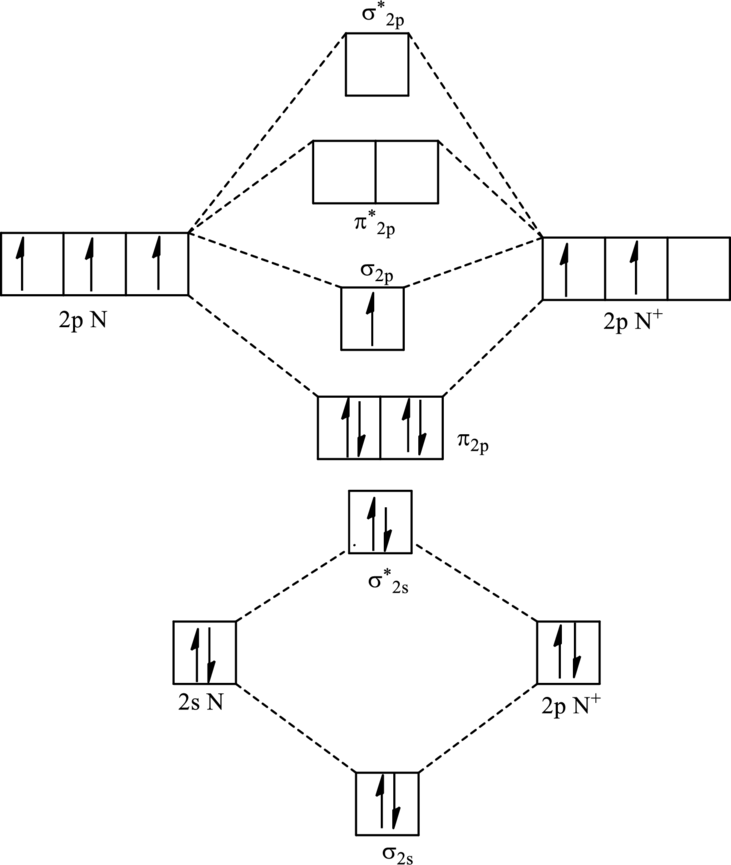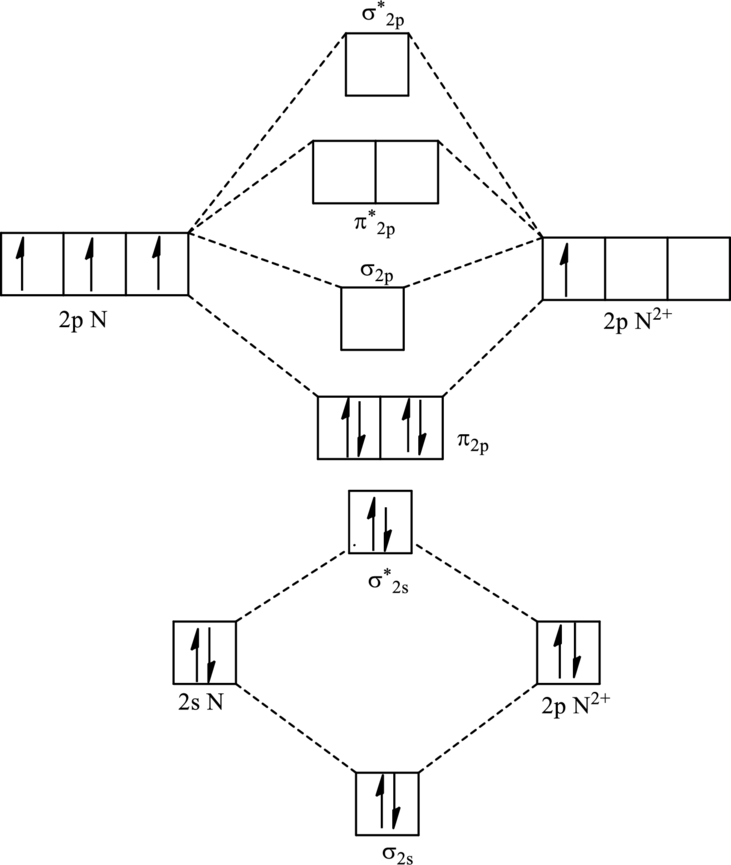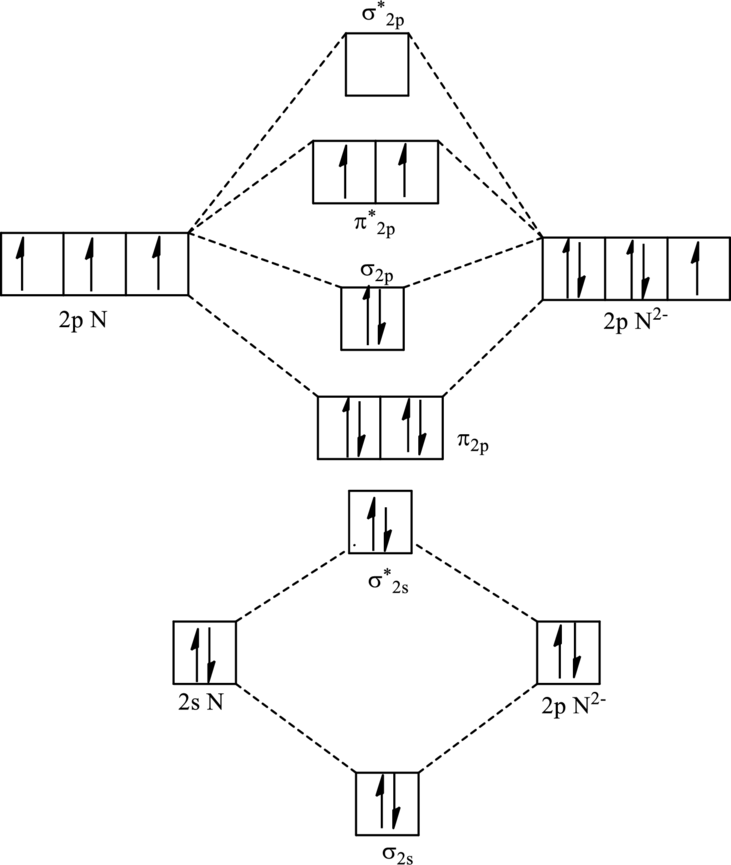
Concept explainers
(a)
Interpretation:
Valence shell electronic configuration of
Concept Introduction:
Molecular orbital diagram is a linear combination of atomic orbitals of similar energy and similar symmetry. It is formed by the proper overlap of the atomic orbitals.
There are 3 types of molecular orbitals as follows:
1. Bonding molecular orbital: They are formed by the constructive interference of atomic orbitals and electrons in it stabilize the molecule and are of lesser in energy.
2. Antibonding molecular orbital: This type of orbitals increases the energy of molecule and destabilizes it and weakens the bond between the atoms.
3. Non-bonding molecular orbital: These types of orbitals have energy similar to atomic orbitals that is addition or removal of electron does not change the energy of molecule.
The order of energy in molecular orbital follows two rules as follows:
1. For
2. For atomic number more than 14 order of energy is,
(a)
Explanation of Solution
For
The symbol for nitrogen is
One positive charge is added up in the total valence count.
Thus total valence electrons is sum of the valence electrons for each atom in
Hence, 9 electrons are to be arranged in each molecular orbital to obtain an electronic configuration. Since number of electrons in
Hence, the electronic configuration of
For
The symbol for nitrogen is
Two positive charges are subtracted from the total valence count.
Thus total valence electrons are sum of the valence electrons for each atom in
Hence, 8 electrons are to be arranged in each molecular orbital to obtain an electronic configuration. Since number of electrons in
Hence, the electronic configuration of
For
The symbol for nitrogen is
Two negative charges are added up in total valence count.
Thus total valence electrons are sum of the valence electrons for each atom in
Hence, 12 electrons are to be arranged in each molecular orbital to obtain an electronic configuration. Since number of electrons in
Hence, the electronic configuration of
(b)
Interpretation:
The bond order of
Concept Introduction:
Bond order
(b)
Explanation of Solution
For
The electronic configuration of
Substitute 7 for number of electrons in bonding orbitals and 2 for number of electrons in antibonding orbitals in equation (1) to calculate bond order.
Hence, the bond order of the molecule
For
The electronic configuration of
Substitute 6 for number of electrons in bonding orbitals and 2 for number of electrons in antibonding orbitals in equation (1) to calculate bond order.
Hence, the bond order of the molecule
For
The electronic configuration of
Substitute 8 for number of electrons in bonding orbitals and 4 for number of electrons in antibonding orbitals in equation (1) to calculate bond order.
Hence, the bond order of the molecule
(c)
Interpretation:
Molecular orbital diagram of
Concept Introduction:
Refer to (a)
(c)
Explanation of Solution
For
The electronic configuration of

Since
For
The electronic configuration of

Since
For
The electronic configuration of

Since
(d)
Interpretation:
Character of highest energy orbital of
Concept Introduction:
Refer to (a)
(d)
Explanation of Solution
For
The electronic configuration of
For
The electronic configuration of
For
The electronic configuration of
Want to see more full solutions like this?
Chapter 2 Solutions
Chemical Principles: The Quest for Insight
- 7.5 1.93 2.05 C B A 4 3 5 The Joh. 9 7 8 1 2 7.5 7.0 6.5 6.0 5.5 5.0 4.5 4.0 3.5 3.0 2.5 2.0 1.5 1.0 ppm 9 7 8 0.86 OH 10 4 3 5 1 2 7.5 7.0 6.5 6.0 5.5 5.0 4.5 4.0 3.5 3.0 2.5 2.0 1.5 1.0 ppm 9 7 8 CI 4 3 5 1 2 7.0 6.5 6.0 5.5 5.0 4.5 4.0 3.5 3.0 2.5 2.0 2.21 4.00 1.5 2.00 2.07 1.0 ppm 2.76arrow_forwardAssign the functional group bands on the IR spectra.arrow_forwardFind the pH of a 0.120 M solution of HNO2. Find the pH ignoring activity effects (i.e., the normal way). Find the pH in a solution of 0.050 M NaCl, including activityarrow_forward
- Please help me answer these three questions. Required info should be in data table.arrow_forwardDraw the major organic substitution product or products for (2R,3S)-2-bromo-3-methylpentane reacting with the given nucleophile. Clearly drawn the stereochemistry, including a wedged bond, a dashed bond and two in-plane bonds at each stereogenic center. Omit any byproducts. Bri CH3CH2O- (conc.) Draw the major organic product or products.arrow_forwardTartaric acid (C4H6O6) is a diprotic weak acid. A sample of 875 mg tartaric acid are dissolved in 100 mL water and titrated with 0.994 M NaOH. How many mL of NaOH are needed to reach the first equivalence point? How many mL of NaOH are needed to reach the second equivalence point?arrow_forward
- Including activity, calculate the solubility of Pb(IO3)2 in a matrix of 0.020 M Mg(NO3)2.arrow_forwardIncluding activity coefficients, find [Hg22+] in saturated Hg2Br2 in 0.00100 M KBr.arrow_forwardIncluding activity, calculate the pH of a 0.010 M HCl solution with an ionic strength of 0.10 M.arrow_forward
- Can I please get the graph 1: Concentration vs. Density?arrow_forwardOrder the following series of compounds from highest to lowest reactivity to electrophilic aromatic substitution, explaining your answer: 2-nitrophenol, p-Toluidine, N-(4-methylphenyl)acetamide, 4-methylbenzonitrile, 4-(trifluoromethyl)benzonitrile.arrow_forwardOrdene la siguiente serie de compuestos de mayor a menor reactividad a la sustitución aromática electrofílica, explicando su respuesta: ácido bencenosulfónico, fluorobenceno, etilbenceno, clorobenceno, terc-butilbenceno, acetofenona.arrow_forward
 Chemistry: Principles and PracticeChemistryISBN:9780534420123Author:Daniel L. Reger, Scott R. Goode, David W. Ball, Edward MercerPublisher:Cengage Learning
Chemistry: Principles and PracticeChemistryISBN:9780534420123Author:Daniel L. Reger, Scott R. Goode, David W. Ball, Edward MercerPublisher:Cengage Learning Chemistry: Principles and ReactionsChemistryISBN:9781305079373Author:William L. Masterton, Cecile N. HurleyPublisher:Cengage Learning
Chemistry: Principles and ReactionsChemistryISBN:9781305079373Author:William L. Masterton, Cecile N. HurleyPublisher:Cengage Learning

